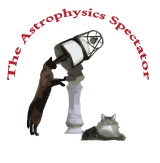
The basic layout of the site is as survey paths, which can be found under the Surveys link at the top of this and most other pages on this site. Each survey begins with a basic overview of the subject. Part of this overview include simulators of astrophysical phenomena that allow the reader to experiment with the phenomena. The later pages in a survey present the subject in greater and more mathematical depth. A path ends with research pages that describe current research projects and results in astrophysics.
The links at the top of each page are Home, which is the current home page of this site, Commentary, which is an index of short essays on topics loosely related to astrophysics, Surveys, which is the index of survey paths, Research, which is the index of research pages and the page leading to recent news items, Background, which is the index page for all background information on astrophysics, including survey pages, simulator pages, tables, bibliographic references, and lists of web resources, Previously, which is an index of previous home pages, and Site Info, which describes the site and its author, and gives contact information.
On the home page is found an addition link. This is the Store link, which leads to reviews of worthwhile books on astronomy and other relates subjects. Links on these pages enable the reader to buy these books from Amazon.com, which helps to financially sustain this web site.
Each Wednesday, a new issue of The Astrophysics Spectator is published that comprises a new home page, a new commentary, whatever news the author notices, and background, research, and simulator pages added to the survey paths. The home page acts as an index to the newly added pages. This site also has an RSS channel, whose link is given at the bottom of the right-hand column of this page.
May 18, 2005
This week in The Astrophysics Spectator I add a new survey path, the “Astrophysical Disks” path. The page on disks presented in this issue gives an overview of the physics of disks. In addition to this starting page, I add a news page and a commentary page.
Disks appear everywhere in astronomy. A disk of gas and dust produced the planets of our Solar System. Disks are found around all four giant planets. They are found around the compact neutron stars and black-hole candidates of compact binary systems. Giant disks surround the massive black-hole candidates at the cores of galaxies. A disk defines the plane of a spiral galaxy.
As varied as these systems are, the basic physics is similar. Disks are found when the gravitational force on a gas or a large collection of objects such as stars or ice blocks is balanced by centrifugal force. The thickness of the disk is determined by the balancing of the gravitational tidal force against the random motion of the objects or the pressure of the gas in the disk. As a disk rotates, with the inner portions rotating faster than the outer portions, the energy associated with the differential rotation is extracted, converted into the kinetic energy of random motion, and then converted into heat and electromagnetic radiation; much of the complex phenomena we see in disks, such as the patterns in spiral galaxies and the complex ringlets of Saturn's ring are produced by this flow of energy.
The commentary for this week discusses a recent commentary in The Wall Street Journal that claims this country is not producing enough physicists and engineers with Ph.D.s, to the detriment of the U.S. economy. I found the authors' arguments to be weak; I believe physics is overstocked with Ph.D.s. I also believe that the shifts we see in the numbers of college degrees in various scientific fields reflect the current market demands.
The news item I discuss is the recent observation of a short-duration gamma-ray burst by the NASA Swift spacecraft. Swift was able to provide an accurate position for this burst, the first time that this has been done for the short-duration bursts. I discuss the implications for the study of these events, particularly in determining their source.
Jim Brainerd
News
NASA's Swift Locates a Short Gamma-Ray Burst (May 11, 2005). The Swift gamma-ray observatory, a NASA satellite that was launched last fall, has produced the first accurate location for a short gamma-ray burst. Previous to this observation, only long gamma-ray bursts had been located. The short bursts behave differently than the long bursts, and they are widely believed to be produced by a different object (long bursts are produced in the supernovae of massive stars). An elliptical galaxy falls on the burst location, but no source for the burst is visible. (continue)
Commentary
A Ph.D. Deficit? Authors of a recent commentary in The Wall Street Journal argue that the United State is producing too few engineers and physicists with Ph.D.s. But the decline in the number of Americans receiving Ph.D.s in physics and engineering is offset by the number receiving them in the biological sciences, which are currently the most dynamic branches of science. Rather than evidence of economic decline, this is evidence that economic resources are being deployed in the most fruitful areas of technological advancement. (continue)
Background
Overview of Astrophysical Disks. Not all objects in astronomy are spheres. When the centrifugal force in a system balances the gravitational force, the system usually has a disk configuration. One sees disks everywhere in the universe, from the rings of Saturn to the planes of spiral galaxies, but despite this broad range of scales, all disks are governed by the same set of principles. This page begins the “Astrophysical Disks” survey path. (continue)

RSS Channel
